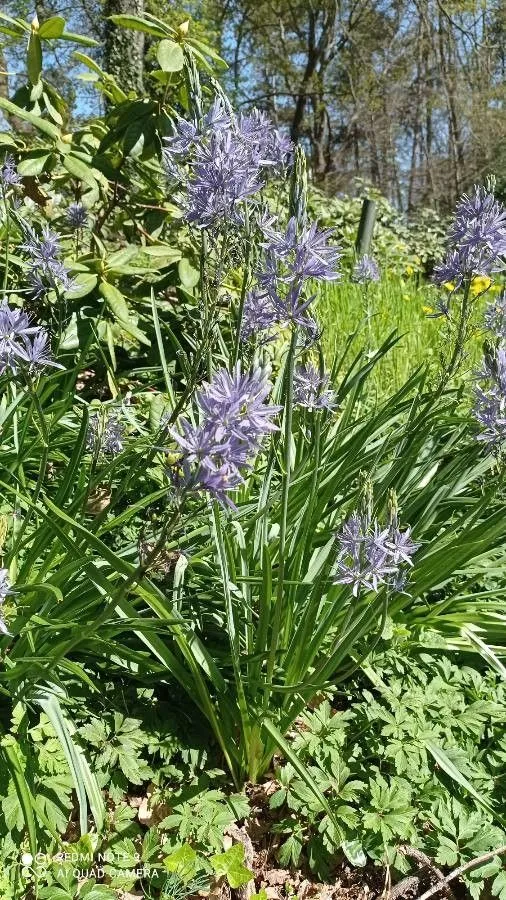
Author: (Pursh) Greene
Bibliography: Man. Bot. San Francisco: 313 (1894)
Year: 1894
Status: accepted
Rank: species
Genus: Camassia
Vegetable: True
Observations: W. Canada to W. U.S.A
Camash, scientifically known as Camassia quamash, is a perennial herbaceous plant that belongs to the Asparagaceae family. This attractive plant, which has been recognized and described as early as 1894 in the Manual of Botany of San Francisco, authored by (Pursh) Greene, is native to various regions stretching from western Canada down through the western United States. It’s admired for its showy clusters of star-shaped flowers, usually ranging in shades of blue, purple, and sometimes white, that bloom in spring and early summer.
One of the notable horticultural features of Camash is its ornamental value. It grows from bulbs and has grass-like leaves that create a lush green base before the flowers emerge. These blooms typically rise on tall, sturdy stems, making them a striking addition to gardens and natural landscapes.
Historically, Camash holds significant ethnobotanical importance. Indigenous peoples of North America, particularly those in the Pacific Northwest, have long valued these plants not just for their beauty but also for their edible bulbs. Camash bulbs were a staple food source, harvested and prepared through various traditional methods, such as roasting and steaming, to mitigate their slightly bitter taste and make them more digestible.
Ecologically, Camash plays a vital role in its native habitats. It provides early season nectar for pollinators, such as bees and butterflies, making it an essential plant for maintaining biodiversity within these ecosystems. Camash thrives in open meadows, grasslands, and forest edges where it can receive ample sunlight.
Cultivating Camash in a garden setting requires attention to specific growing conditions. It prefers well-drained soil and can tolerate both full sun and partial shade, although it prospers best with plenty of light. Planting Camash bulbs in the fall will usually ensure a splendid display of flowers in the following spring. Additionally, once established, these plants are relatively low maintenance and can multiply over the years, enhancing the garden’s beauty while creating a naturalized environment.
In conclusion, Camassia quamash, or Camash, is a plant of both practical and aesthetic value, with a rich historical background and significant ecological contributions. Its captivating flowers and adaptability make it a cherished addition to various landscapes, honoring the legacy of its traditional uses and embracing its role in contemporary horticulture.
Eng: blue camass, camash, camosh, common camas, common camash, quamash, small camas, blue camas, star camas
Swe: ätlig stjärnhyacint
Fra: camassie camash, quamassie
En: Camash, Camosh, Common camas, Common camash, Blue camass, Quamash, Small camas, Blue camas, Common quamash, Indian hyacinth, Quamosh, Star camas
Ar: كماس مألوف
Zh: 北美百合
Da: Spiselig Kamassia
Fi: Sinitähtihyasintti
Fr: Pommes des prairies, Camassie camash, Quamassie
De: Essbare Prärielilie
Pl: Kamasja Leichtlina
Ru: Камассия квамаш
Sv: Ätlig stjärnhyacint
Taken Apr 18, 2022 by Patrick Ducrocq (cc-by-sa)
Taken May 11, 2022 by Graham Boothman (cc-by-sa)
Taken May 2, 2019 by loulou Le (cc-by-sa)
Taken Apr 19, 2022 by Alexandre Debouté (cc-by-sa)
Taken Apr 28, 2019 by randa keys (cc-by-sa)
Taken Jan 1, 1900 by EOL − Walter Siegmund (cc-by-sa)
Taken May 30, 2014 by EOL − Janet Zipser Zipkin (cc-by-nc)
Taken Jan 1, 1900 by EOL − Walter Siegmund (cc-by-sa)
Taken Jun 7, 2013 by EOL − Sam McNally (cc-by-nc)
Taken Apr 13, 2021 by Denis Alkan (cc-by-sa)
Taken May 26, 2019 by korf (cc-by-sa)
Taken May 8, 2022 by Stoelinga Peter (cc-by-sa)
Taken May 8, 2022 by angelique sibille (cc-by-sa)
Taken Apr 20, 2021 by DOMINIQUE (cc-by-sa)
Taken May 20, 2021 by Thom van oosten (cc-by-sa)
Taken May 27, 2020 by Ethan Greer (cc-by-sa)
Taken May 2, 2021 by Nick Edmonds (cc-by-sa)
Taken Oct 15, 1998 by EOL − Charles Webber (cc-by-nc-sa)
Taken Oct 15, 1998 by EOL − Charles Webber (cc-by-nc-sa)
Taken Oct 16, 1998 by EOL − Charles Webber (cc-by-nc-sa)
Taken Oct 15, 1998 by EOL − Charles Webber (cc-by-nc-sa)
Growth form>: Single Crown
Growth habit>: Forb/herb
Growth rate>: Moderate
Ph maximum: 7.0
Ph minimum: 5.7
Family: Myrtaceae Author: (F.Muell.) K.D.Hill & L.A.S.Johnson Bibliography: Telopea 6: 402 (1995) Year: 1995 Status:…
Family: Rubiaceae Author: Pierre ex A.Froehner Bibliography: Notizbl. Bot. Gart. Berlin-Dahlem 1: 237 (1897) Year:…
Family: Sapindaceae Author: Koidz. Bibliography: J. Coll. Sci. Imp. Univ. Tokyo 32(1): 38 (1911) Year:…
Family: Asteraceae Author: A.Gray Bibliography: Pacif. Railr. Rep.: 107 (1857) Year: 1857 Status: accepted Rank:…
Family: Fabaceae Author: Medik. Bibliography: Vorles. Churpfälz. Phys.-Ökon. Ges. 2: 398 (1787) Year: 1787 Status:…
Family: Aspleniaceae Author: (Cav.) Alston Bibliography: Bull. Misc. Inform. Kew 1932: 309 (1932) Year: 1932…